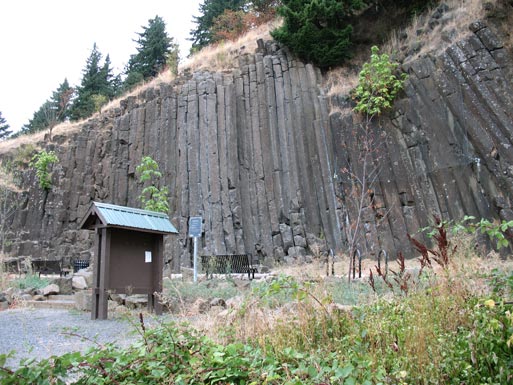The Skinner Butte Columns are a group of relatively uniform high quality dark-colored columnar basalt which likely formed as a magma sill intrusion, then cooled to become gradually exposed through erosion, although a portion of the site was used for quarry material in the not-too-distant past. The bluff height is 45’ tall and each column tends to lean leftward at a 70° degree angle. The cracks between the columns are excellent for various types of finger-to-hand-to-fist jams and present abundant opportunities to place rock gear protection while on lead.
 The Columns are available for year-round climbing and even though Oregon gets plenty of rain the small cliff does quickly dry because of the southwesterly orientation.
Expect full sunlight on the rock face from about 10AM to sunset. You can usually climb 20-30 minutes past sunset with decent light.
The site is not conducive to extensive bouldering but the ease of setting up top-rope belays alleviates this.
The Columns are available for year-round climbing and even though Oregon gets plenty of rain the small cliff does quickly dry because of the southwesterly orientation.
Expect full sunlight on the rock face from about 10AM to sunset. You can usually climb 20-30 minutes past sunset with decent light.
The site is not conducive to extensive bouldering but the ease of setting up top-rope belays alleviates this.
The site is within the boundary of the Eugene city park and features basic site improvements such as steel chairs, a sign board, and wood chip ground cover. Local climbers also provide some care for the site.
There are ultimately four common sources for directions and beta to the Skinner Butte Columns:
1. Northwest Oregon Rock
2. Rock Climbing Western Oregon, by Greg Orton
3. Rock Climbing Oregon, by Adam Bolf and Ben Ruef
4. Weekend Rock, by Ron Horton
Acquire the above guidebooks.
Services and Amenities: Eugene has gas stations, grocery stores, restaurants, fast-food eateries, grills, and pubs.
Camping and Lodging: Campgrounds can be found at the outskirts of the city. Nearby lodging (motel and hotel) arrangements do exist.
Administrative Agency: The site is managed by the Eugene Parks and Recreation Department.
Seasonal Factors: The site is open year-round, but can be damp after rains in winter until the sunshine dries out the rock face.
Road access conditions: Paved roads travel past the site.
